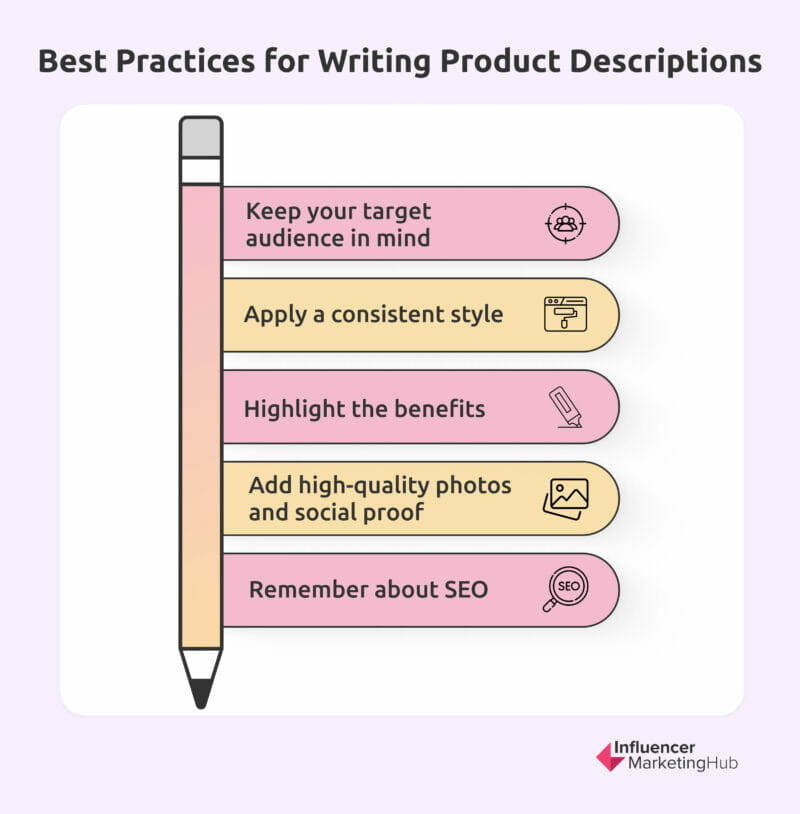If you’ve been following the news, you would know by now that 2024 is going to be the year of artificial intelligence. Social feeds are blowing up with conversations about ChatGPT. Though, can it be of any use if you need to write product descriptions?
A product description might be short, but it can take almost an eternity to string together those few sentences. Then, just as you thought you’re done, new products have been added and, you’ve guessed it, these also need unique descriptions.
Considering that it’s such a time-consuming and repetitive task, it can be worthwhile to experiment with a tool like OpenAI.
Here’s how teams in charge of content generation can use this promising app to free up time. We also include a couple of practical tips for writing eCommerce product descriptions that you can keep in the back of your mind as you edit your AI-generated descriptions.
Automate Writing eCommerce Product Description with OpenAI [Practical Tips]:
What’s OpenAI?
If all this conversation about OpenAI is still new to you, here’s the basics that you need to know. OpenAI is a research lab that concentrates on creating and improving AI technologies. It uses deep learning algorithms to create intelligent systems. These systems can be used for various purposes including machine learning and natural language processing.
What makes it so useful for eCommerce applications is that it has a number of integrations. You can, for instance, integrate it into your Shopify store and other leading shopping platforms. This way, you can leverage powerful functionality to help you personalize the shopping experience, segment your customers better, and automate support.
Using OpenAI for Writing Product Descriptions
You can use OpenAI to automate much of the process. Obviously, we put OpenAI to the test and asked how to use it for writing product descriptions.
We want to say that here’s it straight from the horse’s mouth. While OpenAI has a lot of horsepower, we don’t know how it will feel about that comparison.
In any case, here’s what OpenAI replied:
You can use OpenAI's GPT-3 API to generate product descriptions by feeding it prompt and parameters, such as the product name and features, and have it generate a description based on that information.
To use OpenAI's API, you will need to sign up for an API key and have some knowledge of coding, as the API requires making HTTP requests and handling the responses in your code.
You can also explore other OpenAI language generation tools that have a more user-friendly interface, such as OpenAI's Codex.
Here are its step-by-step instructions:
- Gather a list of products and the descriptions you want to create.
- Create an OpenAI account and log in.
- Select the “Create New Model” option and enter your product list and descriptions into the text box.
- Configure the model settings to ensure that it generates product descriptions that are accurate and unique.
- Train the model by providing it with sample product descriptions you have written.
- Test the model’s output by generating product descriptions for your products.
- Adjust the model settings as needed until you are satisfied with the output.
- Use the generated product descriptions on your website or in your marketing materials.
As you can see, it doesn’t automate the entire process. You’ll still need some coding knowledge to be able to train it. You’ll need to have relevant product descriptions that you can use as examples that have been written by a human content writer. These pre-written descriptions should describe your brand using the tone of voice that you have in mind. Basically, it will take time and human intervention to train its model.
If this work sounds too technical or drawn-out and you have only a few products, you can go the “manual route” and simply enter an instruction to write a product description for a specific product.
Here’s what it generated when asked to generate a product description for a 4-pack of AA high-performance alkaline batteries:
"This 4 Pack of AA High-Performance Alkaline Batteries is the perfect choice for powering all your devices. These batteries are made with the highest quality materials and are designed to last longer and provide more power than standard alkaline batteries. With an impressive shelf life of up to 10 years, these batteries are sure to get the job done. They have a higher capacity, which means they will last longer when powering your devices. Plus, they are leak-proof and corrosion-resistant, meaning your devices will remain safe and secure. Get your 4 Pack of AA High-Performance Alkaline Batteries today and power your devices with the best."
To help you judge the quality of this product description better, here’s Amazon’s own description for this product:
- IN THE BOX: 4-pack of 1.5 volt AA alkaline batteries for reliable performance across a wide range of devices
- DEVICE COMPATIBLE: Ideal battery for game controllers, toys, flashlights, digital cameras, clocks, and more
- DESIGNED TO LAST: 10-year leak-free shelf life; store for emergencies or use right away
- EASY USE & STORAGE: Ships in easy-to-open packaging
- SINGLE USE: These batteries are NOT rechargeable; for rechargeable options, check out Amazon Basics rechargeable batteries
Best Practices for Writing Product Descriptions
As mentioned earlier, you’ll still need to edit and tweak the product description that OpenAI generated. When it’s time for you to put on your own writing cap, here are a couple of best practices to keep in mind.

Keep your target audience in mind
You can describe the exact same product in different ways. Some features will be more important than other features to certain members of your target audience. This will impact which product details will be a priority and which info you can shift to the bottom or perhaps even leave out. For example, is ease of use more important than durability to your target audience? Or, will the appearance far outweigh the price?
Your target market will also impact the length, choice of words, style, and tone. For example, should you keep it more formal perhaps? What about humor?
Basically, how would you sell the product to them if they were to enter your brick-and-mortar store? Let this guide you. However, also remember as they won’t be able to see and touch the product themselves, you’ll need to be more thorough in your descriptions. This means that you might have to state the obvious.
Apply a consistent style
In addition to ensuring that you use the same tone of voice across the board, also decide on a specific style and stick to that. For example, if you decide to list the features and specs, do so for all the descriptions. And, if this will be your format of choice, don’t use numbering for one product only to use bullet points for the next one. This hurts your branding and just ends up confusing website visitors.
Whatever you decide on, it should read easily. Better yet, if it can be scanned quickly.
Highlight the benefits
While your product descriptions should describe all the specs in detail, it should go beyond simply listing the facts. Storytelling can be quite effective. Perhaps the product idea came to you because you struggled with a specific pain point?
If your products don’t necessarily have an interesting backstory, turn your focus to the benefits that it can offer. Take the example of batteries… Instead of just mentioning the hours of battery life that they can expect, how about the hours of fun or convenience that they can look forward to? Once again, keep your target audience in mind when identifying the most important benefits.
Add high-quality photos and social proof
This is one area where OpenAI won’t be of much use. Sure, high-quality product photos are a different element altogether, but social proof can be incorporated into the actual wording.
Not only can social proof help to build credibility, but it can also be that little bit of encouragement that a potential new customer might need to convert. Social proof doesn’t necessarily need to be a long customer review. It can also take the form of a short phrase like “customer favorite”, “number-one seller”, or “most popular choice”.
Remember about SEO
Your product descriptions don’t operate in isolation. They’re part of a bigger system and just like your social media posts should incorporate certain keywords and SEO best practices, so, too, should your product descriptions.
Should You Use AI?
At the end of the day, it’s a classic example of working smarter instead of harder. OpenAI isn’t perfect. It also can’t do everything for you. What it can do, however, is free up time by writing a decent first draft that you can improve on.
One drawback of using OpenAI for product descriptions is the word count, or rather character limit. Sure, product descriptions don’t have to be the length of a blog post (in fact, they shouldn’t be), but you might find that you need more than 4,000 characters.
Also, in order for this new route to be of use to you, you still need to have information about your product and your ultimate goal. While the best practices that we’ve mentioned above recommend that your product description should go beyond simply listing the key information, if you’re more concerned about just sharing product details than what you are to make a sale, your final result will look differently.
To sum up, this means that you still need to research your product. You’ll also need to research your target audience. That alone takes time.
Then, there’s the proofreading. In addition to any glaring spelling issues, there are finer details like changing a sentence that uses passive voice into active voice. In fact, that’s what OpenAI suggests. Weak verbs should also be replaced with action words. You get the idea. It’s more than a simple grammar check that you can run through another AI-powered writing tool like Grammarly.
Wrapping Things Up
Here’s the thing about using OpenAI to write your product descriptions for your online store — it will still require human input from your side. It’s not a perfect tool. You’ll still need writing skills to be able to change the descriptions that the AI generated into effective product descriptions.
Also, you’ll need to invest some time into fine-tuning it. Be warned that this part of the process can get quite technical.
Then, you’ll still need to edit the product descriptions to see where it can be improved. For example, generic words like “beautiful” and “great” aren’t very effective. Instead, you want to use more specific words. This is something that you’ll most likely find AI struggles with. At the same time, you want to stay clear from using words that are clearly an example of over-exaggeration. In other words, if your product isn’t the best, don’t claim that it is. Basically, you’ll want to scan the text and remove any superlatives as well words for which there’s a more descriptive version.
While it sounds like a lot of work, remember that your product descriptions are essentially your new salesperson. They do a lot of work and deserve that you invest the same hard work into creating them. Sure, let OpenAI do a lot of the heavy lifting, but be ready and willing to put in the hours too.


